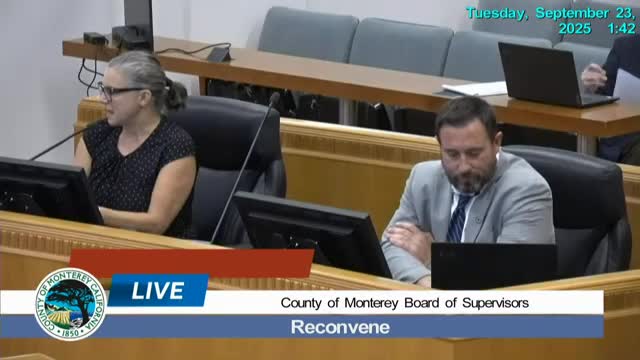Monterey County Board Adopts New Coastal Vacation Rental Regulations Amid Community Concerns
September 24, 2025 | Monterey County, California
This article was created by AI summarizing key points discussed. AI makes mistakes, so for full details and context, please refer to the video of the full meeting. Please report any errors so we can fix them. Report an error »

In a pivotal meeting held on September 23, 2025, the Monterey County Board of Supervisors gathered to finalize regulations governing vacation rentals in the coastal zones of unincorporated Monterey County. The atmosphere was charged with anticipation as staff presented an ordinance aimed at amending various definitions and zoning sections of the county code to better regulate short-term rental properties.
The proposed regulations follow a series of steps taken since August 2024, when the board first adopted vacation rental regulations for inland areas. These regulations took effect in October 2024, and the phase-out period for unpermitted operations concluded in April 2025. The coastal regulations, which received approval from the California Coastal Commission in August 2025, are now set to be implemented, with a compliance deadline for existing operations by December 24, 2025.
The new framework categorizes vacation rentals into three types: homestays, limited vacation rentals, and commercial vacation rentals. Homestays, where owners occupy at least one bedroom, are allowed without caps but limited to one rental contract every seven days. Limited vacation rentals, which are not owner-occupied, can operate up to three times a year under similar conditions. In contrast, commercial vacation rentals, which can be rented more frequently, require a discretionary approval process and are subject to caps based on planning areas.
The board's discussions highlighted the importance of aligning these regulations with local land use plans, ensuring that they reflect the unique characteristics of areas like Big Sur and Carmel. Supervisors expressed gratitude for the collaborative efforts that led to this moment, acknowledging the extensive community engagement and the careful consideration of local land use policies.
As the meeting progressed, staff provided updates on the current status of vacation rentals, noting a slight increase in permitted operations compared to previous years. They also emphasized the need for ongoing coordination with the Treasurer Tax Collector to track transient occupancy tax revenues, which have remained stable over the past few years.
Looking ahead, the board plans to revisit the regulations in February 2026 to assess their effectiveness and gather data on compliance. This ongoing evaluation will ensure that the regulations adapt to the evolving landscape of vacation rentals while balancing community needs and environmental considerations.
With the coastal zone regulations poised to take effect on October 24, 2025, the board's actions mark a significant step in managing the impact of vacation rentals in Monterey County, reflecting a commitment to sustainable tourism and community integrity.
The proposed regulations follow a series of steps taken since August 2024, when the board first adopted vacation rental regulations for inland areas. These regulations took effect in October 2024, and the phase-out period for unpermitted operations concluded in April 2025. The coastal regulations, which received approval from the California Coastal Commission in August 2025, are now set to be implemented, with a compliance deadline for existing operations by December 24, 2025.
The new framework categorizes vacation rentals into three types: homestays, limited vacation rentals, and commercial vacation rentals. Homestays, where owners occupy at least one bedroom, are allowed without caps but limited to one rental contract every seven days. Limited vacation rentals, which are not owner-occupied, can operate up to three times a year under similar conditions. In contrast, commercial vacation rentals, which can be rented more frequently, require a discretionary approval process and are subject to caps based on planning areas.
The board's discussions highlighted the importance of aligning these regulations with local land use plans, ensuring that they reflect the unique characteristics of areas like Big Sur and Carmel. Supervisors expressed gratitude for the collaborative efforts that led to this moment, acknowledging the extensive community engagement and the careful consideration of local land use policies.
As the meeting progressed, staff provided updates on the current status of vacation rentals, noting a slight increase in permitted operations compared to previous years. They also emphasized the need for ongoing coordination with the Treasurer Tax Collector to track transient occupancy tax revenues, which have remained stable over the past few years.
Looking ahead, the board plans to revisit the regulations in February 2026 to assess their effectiveness and gather data on compliance. This ongoing evaluation will ensure that the regulations adapt to the evolving landscape of vacation rentals while balancing community needs and environmental considerations.
With the coastal zone regulations poised to take effect on October 24, 2025, the board's actions mark a significant step in managing the impact of vacation rentals in Monterey County, reflecting a commitment to sustainable tourism and community integrity.
View full meeting
This article is based on a recent meeting—watch the full video and explore the complete transcript for deeper insights into the discussion.
View full meeting
